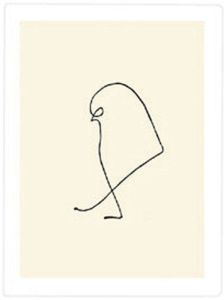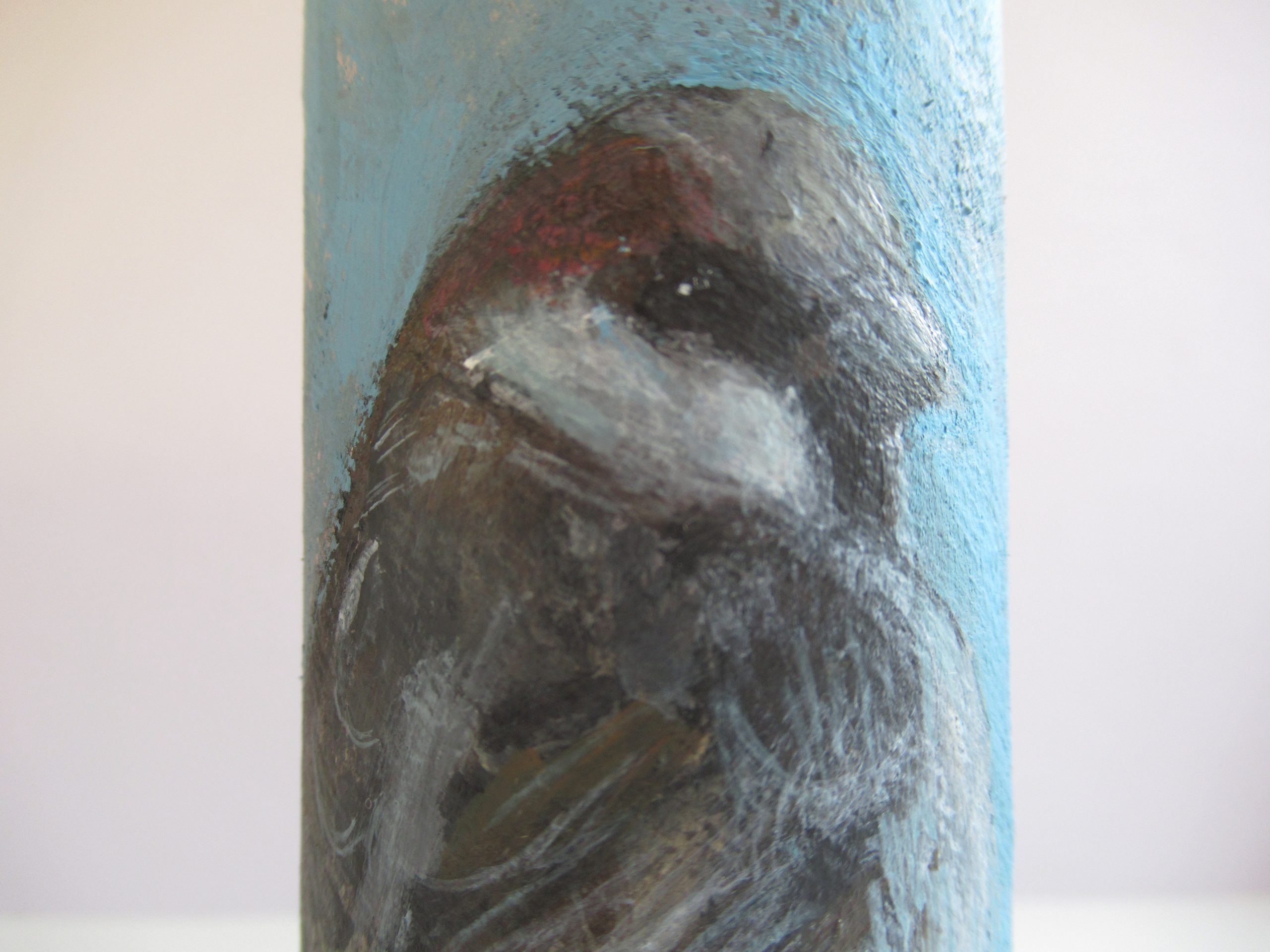
(paint on toilet roll) (2020)
Obituaries lift the heart. They’re the part of any newspaper or magazine to turn to first if you want to cheer yourself up by reading about the positive side of human nature. At the moment, when the news pages resemble an unending nightmare by Hieronymus Bosch, that’s especially true. Last week I read on Twitter a notice about the death of Denis Summers-Smith, an engineer and naturalist who devoted almost his whole life – he lived to be 99 – to two interests: tribology, how surfaces interact mechanically, and the close study of a single small bird, the sparrow.
Summers-Smith was introduced to birds by a naturalist uncle during summer holidays in County Donegal. After the Second World War – he was badly wounded in Normandy after the D-Day landings – he chose the house sparrow to study, simply because it was common and close to hand. Eventually he crystallised his knowledge about Passer domesticus in The house sparrow, a book in the Collins New Naturalist series, long out of print and now hard to find. Later he branched out to study other birds of the sparrow family, using his travels as an engineer to collect knowledge about a bird that inhabits all continents except Antarctica. The ornithologist Stephen Moss wrote in response to the death notice, ‘Denis was a wonderful, kind man, a great amateur scientist in the best traditions of that word, and as humble as the sparrows he devoted his life to studying.’

(Wellcome Library)
The reason why the death of Summers-Smith caught my eye is that I’ve spent so much time lately observing our local house sparrows. There’s a new version of the pathetic fallacy abroad at the moment: that during the lockdown animals have reclaimed their natural spaces, and that birds are singing louder than they used to (actually, the reverse is true). The fallacy arises, I think, because many humans have much more time to pay more attention to the natural world in their gardens and other close-by places. This can only be a good thing, like the slower pace of life in general under the virus.
All kinds of birds fly in to our back garden and sing, but the house band consists of sparrows. They live in a long beech hedge. Since 1992 we and our neighbours have let the hedge grow out and up, so that it’s now nearly two metres thick and between three and four metres tall – a perfect tangle of twigs and leaves for the hiding of birds, and nests. On sunny days the sparrows strut in a row on the top of the hedge, rearranging their feathers and nattering to one another. Occasionally one will lift off vertically, like a bored guest scanning the room for better company, and come to rest a bit further down the hedge. Or another will swoop on the seed tubes or fatballs, usually following by others, since they tend to move round in a gang. ‘Pecking order’, I’ve noticed, isn’t just a metaphor. There really is a feeding hierarchy of species, with sparrows at the bottom of the social pile. They don’t come top, either, of most people’s list of favourite songsters. All they emit is a short, clipped cheep or two to announce their presence. Sometimes they form a scratch chorus, as when a magpie, the profiteering price-gouger of the bird world, lands on the hedge nearby and burrows into it looking for free food.

Sparrow on a bamboo branch
(16th century) (Univ of Michigan)
Perhaps because they’re innocent enough to live so close to humans, sparrows have been hunted and shot at in many countries – farmers particularly dislike them, for ‘stealing’ seed – and, like common members of the ‘lower’ classes down the ages, they tend to get overlooked, denigrated and persecuted. As part of his Great Leap Forward in the late 1950s Mao Zedung identified them as one of the four great pests of China, recruiting three million people into ‘shock battalions’ to eradicate them. Later he repented, when he saw the ill effects of exterminating them, and ordered them to be conserved. 250,000 sparrows had to be imported from the Soviet Union to replenish the population. In the United States, unsurprisingly, it’s legal to kill sparrows for any reason, and many people do. Bird counts show that there’s been a large drop in sparrow populations since the 1970s. Denis Summers-Smith helped fund a research competition, run by the Independent in 2000, that tried to identify the reason. The winner put the main blame on the decline of insects, which nestling sparrows rely on as part of their diet.
Commonness, and their habit of open copulation, are maybe connected with a persistent popular belief about sparrows in the Western tradition, that they’re unusually lewd and promiscuous. (Actually sparrows behave rather like humans: Summer-Smith was surprised when DNA studies showed that extra-marital coupling is common, though conducted more discreetly than that between established pairs.) The Greek poet Sappho connected them with the goddess of love, Aphrodite, and two of Catullus’s best-known poems connect lust and his lover Lesbia’s pet sparrow. (‘Passer’ is the word, though whether it was biologically a sparrow is doubtful, because sparrows make poor pets). In poem 2, ‘Passer, deliciae meae puellae’, Lesbia teases and flirts with her pet in a way that leaves the poet ‘all shiny with desire’. By poem 3 the bird has died, ‘gone on the dark journey from which they say no one returns’, leaving Lesbia red-eyed with grief – which, implicitly, distracts her from her lover’s attentions.

Pair of scissors and sparrow
The ‘Lesbia and sparrow’ tradition had a long life. The sixteenth century poet John Skelton wrote a mock-elegy Philip Sparrow, in which a woman, Jane Scrope, develops strong feelings towards her pet sparrow. Later, the English romantics were more generous-minded and well-informed in their fellow-feeling for the bird. John Keats, in a letter of 1817 to Benjamin Bailey, wrote that ‘the setting sun will always set me to rights, or if a sparrow come before my window, I take part in its existence and pick about the gravel.’ (Keats maybe knew that sparrows need to eat grit to digest the seeds and other food they eat.) John Clare, the keenest of birder poets, sees the cheerful sparrow, in his poem Autumn, as a prophet of warmer seasons yet to come:
I love to see the shaking twig
Dance till the shut of eve
The sparrow on the cottage rig
Whose chirp would make believeThat spring was just now flirting by
In summers lap with flowers to lie
There’s a different poetic take on the sparrow, that fixes on its social class. You might expect T.S. Eliot to take a haughty, patrician view, and you’d be right. In his disgusted, anti-urban poem Preludes, written in 1910 or 1911, he has the phrase ‘and you heard the sparrows in the gutter’. A more democratic writer, Norman MacCaig, must have remembered Eliot’s dismissive phrase in his poem Sparrow, which lifts the ‘proletarian bird’ from ‘a punch-up in a gutter’ to the high heavens:
He’s no artist
His taste in clothes is more
dowdy than gaudy.
And his nest – that blackbird, writing
pretty scrolls on the air with the gold nib of his beak,
would call it a slum.
To stalk solitary on lawns,
to sing solitary in midnight trees,
to glide solitary over gray Atlantics –
not for him: he’d rather
a punch-up in a gutter.He carries what learning he has
lightly – it is, in fact, based only
on the usefulness whose result
is survival. A proletarian bird.
No scholar.But when winter soft-shoes in
and these other birds –
ballet dancers, musicians, architects –
die in the snow
and freeze to branches,
watch him happily flying
on the O-levels and A-levels
of the air.

In the Christian tradition the sparrow’s ordinariness made it an emblem of the equality of created creatures under God’s will. According to Matthew’s gospel Jesus, said, ‘Are not two sparrows sold for a copper coin? And not one of them falls to the ground apart from your Father’s will.’ (He rather spoils that by adding the anthropocentric judgement, ‘fear ye not therefore, ye are of more value than many sparrows’.) Hamlet refers to the phrase late on in Shakespeare’s play, as he faces death at the hands of Laertes. He rejects Horatio’s pleas to withdraw from the duel, saying, with fate rather than providence in mind: ‘There is a special providence in the fall of a sparrow. If it [death] be now, ’tis not to come; if it be not to come, it will be now; if it be not now, yet it will come – the readiness is all.’
The twin threads of sparrow imagery, erotic attraction and social status, are combined by Emily Dickinson in her poem ‘Her breast is fit for pearls’ (poem 84):
Her breast is fit for pearls,
But I was not a “Diver” –
Her brow is fit for thrones
But I have not a crest.
Her heart is fit for home —
I—a Sparrow—build there
Sweet of twigs and twine
My perennial nest.
The word ‘crest’, introduced in the fourth line as a badge of high birth, prefigures the appearance of the humble bird (the American tree sparrow can seem to possess a crest) and its impressive ability to survive all fortunes (‘my perennial nest’).
It’s interesting to learn that, though sparrow populations may be dwindling in many countries, including England, here in Wales numbers are increasing, almost doubling between 1995 and 2012. The sparrow will survive our predations. And, who knows, it may outlive us.

Leave a Reply to Richard Saville Cancel reply